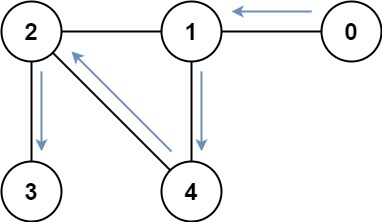Algorithm
Problem Name: 847. Shortest Path Visiting All Nodes
You have an undirected, connected graph of n nodes labeled from 0 to n - 1. You are given an array graph where graph[i] is a list of all the nodes connected with node i by an edge.
Return the length of the shortest path that visits every node. You may start and stop at any node, you may revisit nodes multiple times, and you may reuse edges.
Example 1:

Input: graph = [[1,2,3],[0],[0],[0]] Output: 4 Explanation: One possible path is [1,0,2,0,3]
Example 2:

Input: graph = [[1],[0,2,4],[1,3,4],[2],[1,2]] Output: 4 Explanation: One possible path is [0,1,4,2,3]
Constraints:
n == graph.length1 <= n <= 120 <= graph[i].length < ngraph[i]does not containi.- If
graph[a]containsb, thengraph[b]containsa. - The input graph is always connected.
Code Examples
#1 Code Example with Javascript Programming
Code -
Javascript Programming
const shortestPathLength = function(graph) {
const N = graph.length
const dist = Array.from({ length: 1 << N }, () => new Array(N).fill(N * N))
for (let x = 0; x < N; x++) dist[1 << x][x] = 0
for (let cover = 0; cover < 1 << N; cover++) {
let repeat = true
while (repeat) {
repeat = false
for (let head = 0; head < N; head++) {
let d = dist[cover][head]
for (let next of graph[head]) {
let cover2 = cover | (1 << next)
if (d + 1 < dist[cover2][next]) {
dist[cover2][next] = d + 1
if (cover == cover2) repeat = true
}
}
}
}
}
let ans = N * N
for (let cand of dist[(1 << N) - 1]) ans = Math.min(cand, ans)
return ans
}
Input
Output
#2 Code Example with Python Programming
Code -
Python Programming
class Solution:
def shortestPathLength(self, graph):
memo, final, q = set(), (1 << len(graph)) - 1, collections.deque([(i, 0, 1 << i) for i in range(len(graph))])
while q:
node, steps, state = q.popleft()
if state == final: return steps
for v in graph[node]:
if (state | 1 << v, v) not in memo:
q.append((v, steps + 1, state | 1 << v))
memo.add((state | 1 << v, v))
Input
Output
